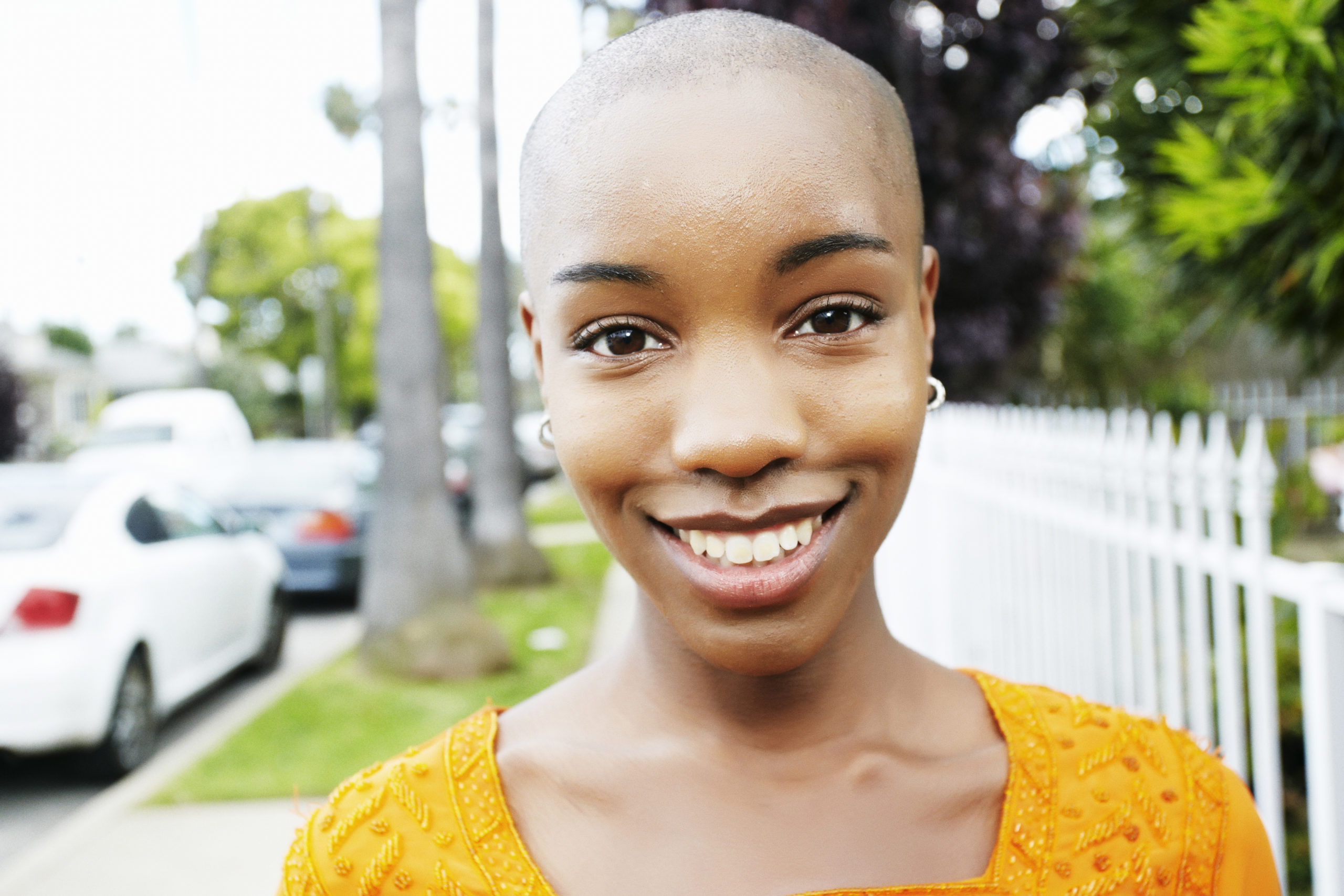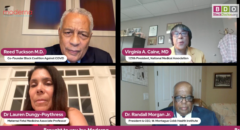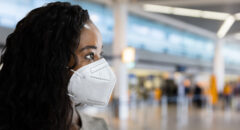
Just recently, the CDC reported that although Black Americans were only slightly more likely to contract COVID-19, they were nearly three times more likely to be hospitalized with it and twice as likely to die from it.
Add in the equally troubling statistics around Black Breast Cancer and, as survivor/thriver Stephanie Walker puts it: “I’m thinking to myself: I have a double whammy. With metastatic breast cancer, we die at a 40% higher rate. And then if all of the sudden I got COVID? I’d be cooked.”
But Black Americans are the most hesitant to get the vaccine, with the lowest vaccination rates of any group (Pew Research Center). More recently, a JAMA study found that young Black women were the least likely to get the COVID-19 vaccine.
When Stephanie—who was diagnosed with breast cancer in 2015—first heard about the vaccine, her response was immediate: “I didn’t want anything to do with it. We still don’t have a cure [for cancer], but you can come up with a vaccine for something that you don’t even know that much about? I’ll take a number at the back of the line.”
How do the vaccines work?
Both COVID-19 vaccines currently in use (Moderna and Pfizer) are mRNA based vaccines. Neither vaccine uses any living (or dead) virus, which means that the vaccine can’t give you COVID-19.
You can think of mRNA as a battle plan and your immune system as an army. When injected, mRNA instructs your cells to make spike proteins that mimic the spikes of the coronavirus. But once built, your immune system says hey you don’t belong here! and attacks the spike proteins. The ensuing battle trains your immune system to recognize and effectively fight off spiked intruders, like coronavirus.
The first injection (which readies the immune system) gives you about 51% immunity; the second (which boosts the immune system’s response) gets you up to 95% immunity.
The Johnson & Johnson vaccine—authorized by the FDA at the end of February—also focuses on spike proteins. It’s a viral vector vaccine, which means that scientists took the spike gene from COVID-19 and put it into a weakened, harmless virus (adenovirus). The adenovirus that carries the spike gene cannot replicate or spread inside your body, which means that it cannot make you sick.
When injected into your body, the harmless virus enters some of your cells and the spike gene inside instructs the cells to make spike proteins. Once your cells have made copies of the spike proteins, your immune system army attacks them. All of the vaccines have the same goal: to teach your immune system to recognize and attack spike proteins.
The J&J vaccine is a single dose shot, meaning you don’t need to schedule two trips to the doctor. Data from the US specifically has shown the vaccine to be 72% effective in keeping you from getting sick and 85% effective in preventing severe illness or hospitalization (FDA). Likely, the J&J vaccine won’t be readily available until April.
How did they develop the vaccines so quickly?
Viral vector vaccines, like the J&J vaccine, have been approved before by the FDA and have been used to vaccinate against diseases like Ebola.
Yes, this is the first time mRNA vaccine technology has been used on such a large scale, but it isn’t new. Actually, the first therapeutic use of mRNA injection was published in 1990 in Science.
And if you’re worried about the integrity of the scientists themselves, look no further than viral immunologist Dr. Kizzmekia Corbett, the brilliant Black woman who co-led the team of scientists that developed the Moderna vaccine. All three vaccines went through rigorous scientific reviews and approval processes that held them to the same standard as other approved vaccines. The overwhelming majority of Black doctors and scientists have said that the vaccines are safe and that they themselves will be vaccinated as soon as possible.
Oftentimes, the vaccine process is slowed by logistics—backlogs of applications, elaborate manufacture and distribution plans. As a global emergency, the COVID-19 vaccine was prioritized and logistics were dealt with quickly. Think about it like a trip to the DMV: If as soon as you arrived, someone handed you the exact forms you needed and you could skip to the front of the line, it would actually be a pretty painless and speedy process.
Does the COVID vaccine work in Black people?
The US medical system has earned the mistrust of black people through a long history of systemic racism. It makes sense to be skeptical of anything they’re trying to stick into your arm.
But you can’t throw the baby out with the bathwater. These vaccines are 72%-95% effective at preventing you from getting COVID-19 and 85%-100% effective in preventing serious illness, which means that on the very slim chance you do happen to contract COVID-19, you likely won’t be hospitalized from it (FDA).
Both clinical trials for the Pfizer and Moderna vaccines had roughly 10% Black participants (FDA). The Johnson & Johnson vaccine had 13% Black participants in its US clinical trial and 19% Black participants in its global trials (J&J).
Most breast cancer treatments went through clinical trials with less than 3% Black participants and were ultimately approved with much lower success rates.
Can breast cancer patients get the vaccine?
None of the current data suggests that the vaccine will affect treatments or threaten the stability of breast cancer patients. In response to a breast cancer survivor, Dr. Fauci said that there is “no evidence that the COVID-19 vaccine will have any effect on your treatment.” In the Pfizer clinical trial, 3.7% of participants were cancer survivors (NYT).
Talk to your treating doctor so that they can advise you on how and when you could get vaccinated. Likely, they will suggest timing your vaccination shots between rounds of chemo, when your immune system is at its strongest. The vaccine won’t make you sick if you are immunocompromised or immunosuppressed, but it might not be as effective in protecting you from getting COVID-19.
How do you weigh the risks and benefits?
We know all too well the risks of COVID-19. “About 20 percent of people who come down with Covid-19 symptoms develop serious, potentially life-threatening illness” (NYT). According to Dr. Monique Gary, a leading breast cancer surgeon, the risk of severe hospitalization or death from
COVID-19 is actually twice that for cancer patients. Even after recovering from COVID-19, common chronic symptoms include exhaustion, insomnia, ‘brain fog,’ cough, joint and chest pain, racing heart, shortness of breath, and loss of sense of smell or taste (CDC).
Our understanding of risks associated with the vaccine are based on the 115.7 million vaccine doses that have been given in the US and the 359.8 million vaccine doses that have been given globally as of March 17th (CDC; Our World in Data). Some minor side effects are normal, especially after the second shot. Outside of a sore arm, you may experience a flu-like response that could include: fatigue, headache, sore muscles and aches, chills, or a low-grade fever. These side effects should go away in 24-36 hours. Based on all the doses given, the CDC has reported that 0.0011% of individuals who received the vaccine have had a severe allergic reaction.
When she thinks about the side effects of the vaccine, Stephanie admits that she’s anxious. “But hell,” she says, “[breast cancer patients] get treatments and we don’t even know what the long-term effects are. They all have side effects. And we roll with those the best we can to live a quality of life.”
In a conversation with the President of Howard University, Dr. Fauci explained that the vast majority of long-term effects from vaccines occur within 30-45 days of vaccination. Given that more than 92.5 million vaccine doses were administered over 45 days ago with no sign of long-term impact, “the chances are extraordinarily low that there’s going to be a significant degree of effects that you’ll see one year or two years from now.”
The low risks and many benefits of being vaccinated ultimately ended up changing Stephanie’s mind. Her bucket list is long: “I want to take a train ride from the east coast to the west coast and back. And to visit a lot of the national parks—Yosemite first. I want to go back to Big Bend [in Texas]. I want to see as much of the United States as I possibly can and spend time with my family in whatever form or fashion that I can.”
“If this vaccine means that I’ll be able to get out and do things a little bit more safely,” Stephanie explained, “then I said to myself, Okay, I’m ready. And that’s when I told my husband, ‘you go first!’”
Still on the fence?
For Stephanie, a big part of her decision came from listening to and talking with trusted Black medical professionals like Dr. Monique Gary, Dr. Sarah Lanell Horton, Dr. Ogori Kalu on our TOUCHBBCA Medical Advisory Board.
If you’re still on the fence about getting the vaccine, look to Dr. Kizzmekia Corbett or Dr. Lisa Fitzpatrick (a leading infectious disease specialist who was in a COVID-19 vaccine trial) or Dr. Valerie Montgomery Rice (the President of Morehouse School of Medicine).
At the end of the day, Stephanie wants breasties to make informed decisions for themselves. “Go read evidence-based information, talk to someone that knows, and decide for yourself. You can’t have someone tell you.”
Stephanie is scheduled to get her first dose of the vaccine on March 5, two days after her husband will receive his second shot. While she’s glad to have it scheduled, she is still a little nervous.
If you’re feeling scared or nervous about the vaccine too, that’s totally normal. If you have questions, reach out to us at [email protected] or 443-758-1924. We are always here for you.
For more information, watch our episode on The Doctor Is In!
And watch Dr. Fauci on BlackDoctor.org!








